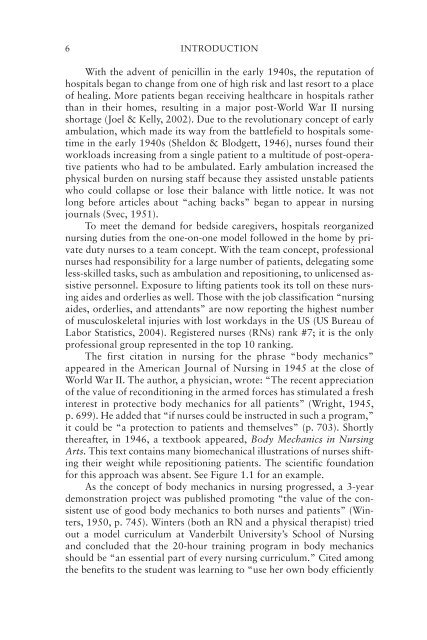Safe Patient Handling and Movement - Springer Publishing Company
Safe Patient Handling and Movement - Springer Publishing Company
Safe Patient Handling and Movement - Springer Publishing Company
Create successful ePaper yourself
Turn your PDF publications into a flip-book with our unique Google optimized e-Paper software.
6 INTRODUCTION<br />
With the advent of penicillin in the early 1940s, the reputation of<br />
hospitals began to change from one of high risk <strong>and</strong> last resort to a place<br />
of healing. More patients began receiving healthcare in hospitals rather<br />
than in their homes, resulting in a major post-World War II nursing<br />
shortage (Joel & Kelly, 2002). Due to the revolutionary concept of early<br />
ambulation, which made its way from the battlefield to hospitals sometime<br />
in the early 1940s (Sheldon & Blodgett, 1946), nurses found their<br />
workloads increasing from a single patient to a multitude of post-operative<br />
patients who had to be ambulated. Early ambulation increased the<br />
physical burden on nursing staff because they assisted unstable patients<br />
who could collapse or lose their balance with little notice. It was not<br />
long before articles about “aching backs” began to appear in nursing<br />
journals (Svec, 1951).<br />
To meet the dem<strong>and</strong> for bedside caregivers, hospitals reorganized<br />
nursing duties from the one-on-one model followed in the home by private<br />
duty nurses to a team concept. With the team concept, professional<br />
nurses had responsibility for a large number of patients, delegating some<br />
less-skilled tasks, such as ambulation <strong>and</strong> repositioning, to unlicensed assistive<br />
personnel. Exposure to lifting patients took its toll on these nursing<br />
aides <strong>and</strong> orderlies as well. Those with the job classification “nursing<br />
aides, orderlies, <strong>and</strong> attendants” are now reporting the highest number<br />
of musculoskeletal injuries with lost workdays in the US (US Bureau of<br />
Labor Statistics, 2004). Registered nurses (RNs) rank #7; it is the only<br />
professional group represented in the top 10 ranking.<br />
The first citation in nursing for the phrase “body mechanics”<br />
appeared in the American Journal of Nursing in 1945 at the close of<br />
World War II. The author, a physician, wrote: “The recent appreciation<br />
of the value of reconditioning in the armed forces has stimulated a fresh<br />
interest in protective body mechanics for all patients” (Wright, 1945,<br />
p. 699). He added that “if nurses could be instructed in such a program,”<br />
it could be “a protection to patients <strong>and</strong> themselves” (p. 703). Shortly<br />
thereafter, in 1946, a textbook appeared, Body Mechanics in Nursing<br />
Arts. This text contains many biomechanical illustrations of nurses shifting<br />
their weight while repositioning patients. The scientific foundation<br />
for this approach was absent. See Figure 1.1 for an example.<br />
As the concept of body mechanics in nursing progressed, a 3-year<br />
demonstration project was published promoting “the value of the consistent<br />
use of good body mechanics to both nurses <strong>and</strong> patients” (Winters,<br />
1950, p. 745). Winters (both an RN <strong>and</strong> a physical therapist) tried<br />
out a model curriculum at V<strong>and</strong>erbilt University’s School of Nursing<br />
<strong>and</strong> concluded that the 20-hour training program in body mechanics<br />
should be “an essential part of every nursing curriculum.” Cited among<br />
the benefits to the student was learning to “use her own body efficiently<br />
14108_C01pg001-026.indd 6 11/11/05 1:24:42 PM

















